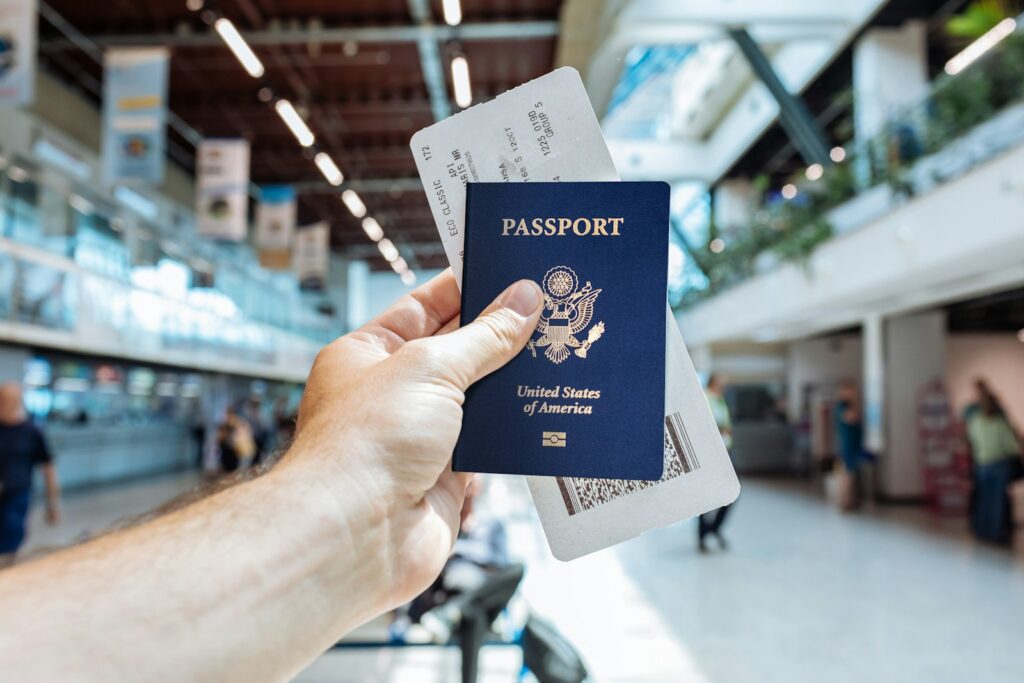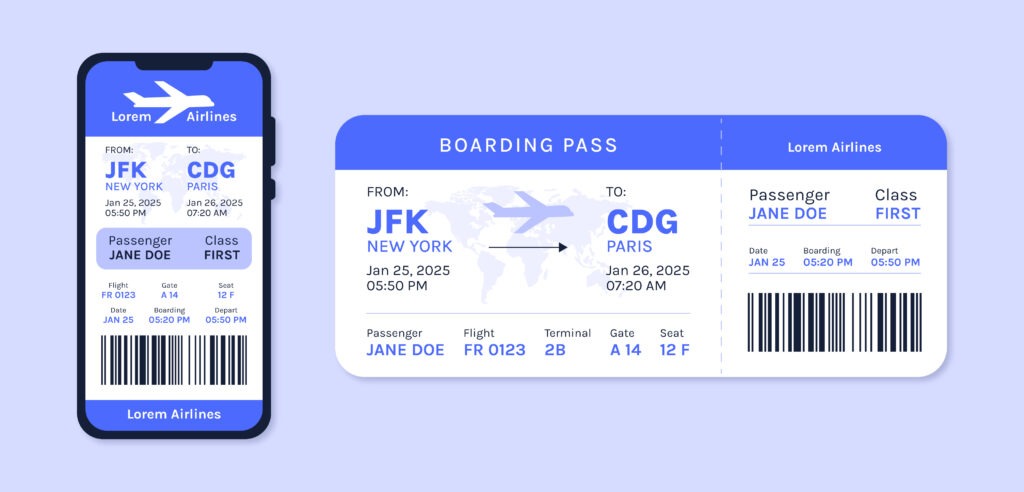Have you ever paused at the airport, holding that small slip of paper or flashing your phone screen, and wondered: what exactly is a boarding pass, and why does it matter? It’s more than just your golden ticket to board the plane—it’s the master key to a smooth and organized journey.
This vital document, regulated by the International Air Transport Association, holds all the details of your trip—whether in physical form or as a digital file on your smartphone. In this article, we’ll break down everything you need to know about boarding passes: what they are, why they’re so crucial, and how to read them like a pro. From decoding cryptic codes to understanding their essential role in your trip, let’s unlock the secrets of your boarding pass together.
What Is a Boarding Pass?

A boarding pass is a document that proves you’ve checked in for your flight and are eligible to board the plane. It’s not just a piece of paper or a digital code—it’s your passport to the air, granting you access through airport security, to the airline’s check-in counter, and ultimately to your seat on the aircraft. Whether it’s issued digitally or printed out, your boarding pass serves multiple purposes beyond just the boarding process. It’s tied to your baggage, ensuring your suitcases end up at the same destination you do, and it provides essential flight details, such as gate information and boarding times. Additionally, your boarding pass plays a crucial role in verifying your entitlements under air passenger rights, especially in cases of delays, cancellations, or other travel disruptions. So, next time you’re preparing for a journey, remember that this document is much more than meets the eye; it’s your all-access pass to a seamless travel experience.
What Does a Boarding Pass Look Like?
There are two main varieties: the traditional paper boarding pass and the modern mobile (or digital) boarding pass. The paper version is typically printed on a rectangular piece of paper, detailing the passenger’s flight information along with a barcode that’s scanned at the gate.
On the digital front, mobile boarding passes can be displayed on smartphones, smartwatches, or tablets, featuring a QR code for gate scanning. It’s fascinating how the design of boarding passes can vary not just between different airlines but even within the same airline at various airports. This diversity means your boarding pass might have a different appearance depending on where and how you print it or the format you choose to receive it in. Regardless of the type, each boarding pass holds key boarding pass info, ensuring you’re ready for your journey.
What Information Does the Boarding Pass Contain?
Embarking on a journey starts with understanding the key piece of travel documentation in your possession: the boarding pass. It’s not merely a ticket to board the plane but a comprehensive guide to your flight specifics. Here’s a rundown of the information typically found on a boarding pass:
- Passenger Name: Confirms the identity of the traveler.
- Frequent Flyer Number/Elite Status: Links to your loyalty program details, if applicable.
- Airline: The carrier operating your flight.
- Flight Number: Specific identifier for your flight.
- Date: Day of your departure.
- Class of Carriage and Fare Class: Indicates the service class and fare type.
- Origin and Destination: Start and end points of your flight.
- Departure Time: When your flight is scheduled to leave.
- Boarding Time: The time passengers are expected to start boarding.
- Gate Number: Where to board your flight.
- Seat Number: Your assigned seat.
- Number of Checked Bags: If applicable, how many bags you’ve checked.
- E-Ticket Number: A digital ticket number.
- Record Locator/Confirmation Code/Passenger Name Record (PNR): A unique code for managing your booking.
Additionally, boarding passes include several abbreviations and codes, which might seem perplexing at first glance. Here’s a simple table to decode some of the most common ones:
| Abbreviation | Full Terminology | Definition |
| SSSS | Secondary Security Screening Selection | Indicates extra security screening. |
| ETKT | E-ticket number | Your digital ticket number. |
| FTQV | Frequent traveler | Your frequent flyer number. |
| PNR | Passenger name record | A unique code for your booking. |
| SEQ/SEQ NO | Sequence number | Your boarding order. |
This comprehensive blend of details ensures you are well-prepared and informed throughout your journey, making your travel experience smoother and more enjoyable.
When Do You Get Your Boarding Pass?
The answer lies in the check-in process. Traditionally, passengers receive their boarding pass at the check-in desk after presenting their flight ticket. This is a tangible confirmation that you’re all set to fly.
However, with the advent of digital conveniences, online check-in has revolutionized how we receive our boarding documents. Most airlines offer the option to check in and download your boarding pass 24-48 hours before your departure. This timeframe can vary, so when do boarding passes become available specifically depends on the airline’s policy and the specific flight.
It’s important to note that policies on issuing boarding passes can differ significantly from one airline to another. This variability underscores the importance of checking with your airline ahead of your flight to ensure you adhere to their specific check-in and boarding pass issuance procedures. Additionally, knowing the ideal time to reach the airport can help you avoid missing the chance to secure your boarding pass, especially if you’re checking in at the airport.
How to Get a Boarding Pass
The process invariably begins with one crucial action: checking in for your flight. Let’s dive into the ways you can obtain your boarding pass, each tailored to different traveler needs and preferences.
Boarding Pass at the Airport Check-in Counter
The most traditional method is at the airport check-in counter. For many, there’s reassurance in the physical exchange — handing over your flight ticket and receiving your paper boarding pass in return. This method suits those who prefer a tangible reminder of their flight details or may not have access to digital options.
Boarding Pass at the Airport Check-in Machine
For those looking to bypass potential lines at the check-in counter, airport check-in machines offer a swift solution. Simply interact with the airline’s check-in machine, input your details, and the machine will print your boarding pass. It’s a straightforward, efficient way to get your boarding pass and proceed to security.
Online Check-in or Mobile Boarding Pass
Perhaps the most convenient method, especially for the tech-savvy traveler, is online check-in. Available from 24-48 hours before your flight, this process allows you to check in and receive a mobile boarding pass directly on your smartphone, tablet, or smartwatch. You can then save this digital pass or, for those wondering, can you print boarding pass at airport machines, self service kiosk, or even at home for added peace of mind.
Additional Note: For travelers with connecting flights under the same airline and PNR (Passenger Name Record), you’ll typically receive all necessary boarding passes at your journey’s outset. This streamlined process ensures you’re prepared for each segment of your trip without needing to check in multiple times.
Paper Boarding Pass vs Mobile Boarding Pass

The debate between opting for a paper boarding pass or a mobile boarding pass is more relevant than ever. Each type has its advantages and considerations, depending on your travel preferences and circumstances.
Some travelers swear by the paper boarding pass, citing the risk of a mobile device running out of battery at a critical moment as a significant concern. The tangible nature of a paper pass can also offer a sense of security, knowing you have your boarding information in hand, without the need to scroll through your phone.
Conversely, the mobile boarding pass is celebrated for its convenience and eco-friendliness. It eliminates the worry of misplacing a thin piece of paper and streamlines your travel documents into one device. For those accustomed to digital organization, having a boarding pass available on a smartphone, tablet, or smartwatch is a seamless fit into their lifestyle.
Expert Advice: Despite the growing preference for digital solutions, there’s wisdom in having a backup. We recommend securing both a paper and a mobile boarding pass whenever possible. This dual approach safeguards against unforeseen situations, like losing your phone or misplacing your paper boarding pass. However, it’s crucial to remember not to print your mobile boarding pass. A printed version of a digital pass is not valid security or TSA – a point often overlooked but important for smooth travel.
Why You Should Keep Your Boarding Pass After the Flight
It might seem inconsequential, but the fate of your boarding pass post-flight warrants careful consideration. The risk of careless disposal or misplacement extends beyond mere loss. The boarding pass, with its QR or 2D barcode, is a repository of sensitive information about you and your travel itinerary. This includes your reservation code, airline code, passenger name, travel dates, flight number, and class—details that are gold mines for data thieves.
The barcodes on your printed boarding pass are not merely symbols; they encode data that could be decoded by individuals with nefarious intentions, potentially leading to identity theft or fraud.
Thus, the advice is clear: do not discard your boarding pass in a public trash bin or leave it behind in the seat pocket in front of you. Instead, take the time to carefully store or destroy it. Shredding is an effective way to ensure that the encoded data does not fall into the wrong hands.
FAQ
No, a plane ticket and a boarding pass are not the same thing. An airline ticket serves as proof of purchase for your flight—it’s essentially a confirmation that you’ve paid for your journey. On the other hand, a boarding pass is what allows you to board the plane. It’s your ticket onto the aircraft, providing flight details and proving that you’ve checked in for your flight.
While mobile boarding passes are increasingly accepted and offer a more convenient and eco-friendly option, do you need to print boarding pass scenarios still arise. We recommend printing your boarding pass as a precautionary measure, even if you have the mobile version. This ensures that you have a backup in case of issues with your phone, such as a dead battery or unexpected technical difficulties.
The straightforward answer is no; you cannot go through security without a boarding pass. The boarding pass is essential for security personnel to verify your identity and confirm your flight details. It acts as your authorization to enter the secure areas of the airport and ultimately board your flight. Always ensure you have your boarding pass—whether paper or digital—readily available to avoid any disruptions to your travel plans.
